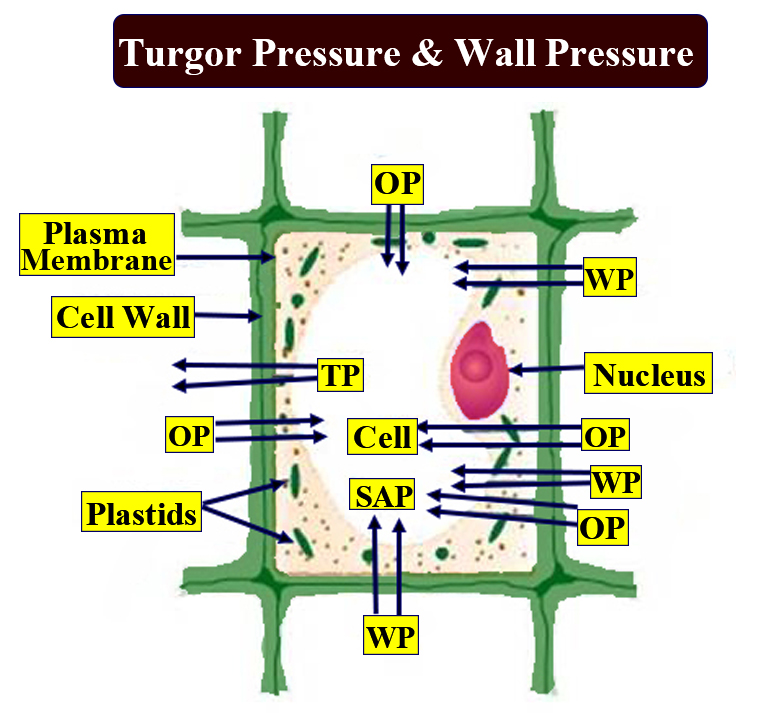
Answer
409.8k+ views
Hint: Plasmolysis is a mechanism that happens as water flows out of the cell and the cell membrane shrinks. This happens when the cell is put in a hypertonic solution (which has more solutes). Water is lost from the cytoplasm, and then the vacuole..
Complete answer:
Turgid refers to cells or tissues that are bloated from the uptake of water. Turgidity is a state of swelling or turgidity, particularly due to high fluid content. Turgidity is a cell state in which the plant cell, having absorbed water, is in a state of stress. A turgid plant cell is a plant cell that has been filled with water due to osmosis.
Turgor Pressure is the force within the cell that forces the plasma membrane against the cell wall and is also known as hydrostatic pressure.
Turgor Pressure is the force within the cell that forces the plasma membrane against the cell wall. Osmotic Pressure (OP) - Suction Pressure (SP) = Turgor Pressure (TP).
Here, OP=42atm and SP=30atm
Therefore, TP= 42-30= 12atm
-The process of plasmolysis does not occur in dead cells.
-This process helps to prove the semipermeability of membranes.
-It is useful in the measurement of osmotic pressure.
So, the correct answer is, “12atm.”
Note:
-Plasmolysis is the opposite state of turgidity. Turgidity is important to make plant cells stand upright.
When the cell is placed in an isotonic solution, there is no net movement of water and when it is placed in a hypotonic solution, the water flows into the cell and exerts pressure on its walls known as turgor pressure. Plant cells that lose a lot of water have less turgor pressure and appear to become flaccid.

Complete answer:
Turgid refers to cells or tissues that are bloated from the uptake of water. Turgidity is a state of swelling or turgidity, particularly due to high fluid content. Turgidity is a cell state in which the plant cell, having absorbed water, is in a state of stress. A turgid plant cell is a plant cell that has been filled with water due to osmosis.
Turgor Pressure is the force within the cell that forces the plasma membrane against the cell wall and is also known as hydrostatic pressure.
Turgor Pressure is the force within the cell that forces the plasma membrane against the cell wall. Osmotic Pressure (OP) - Suction Pressure (SP) = Turgor Pressure (TP).
Here, OP=42atm and SP=30atm
Therefore, TP= 42-30= 12atm
-The process of plasmolysis does not occur in dead cells.
-This process helps to prove the semipermeability of membranes.
-It is useful in the measurement of osmotic pressure.
So, the correct answer is, “12atm.”
Note:
-Plasmolysis is the opposite state of turgidity. Turgidity is important to make plant cells stand upright.
When the cell is placed in an isotonic solution, there is no net movement of water and when it is placed in a hypotonic solution, the water flows into the cell and exerts pressure on its walls known as turgor pressure. Plant cells that lose a lot of water have less turgor pressure and appear to become flaccid.

Recently Updated Pages
Who among the following was the religious guru of class 7 social science CBSE

what is the correct chronological order of the following class 10 social science CBSE

Which of the following was not the actual cause for class 10 social science CBSE

Which of the following statements is not correct A class 10 social science CBSE

Which of the following leaders was not present in the class 10 social science CBSE

Garampani Sanctuary is located at A Diphu Assam B Gangtok class 10 social science CBSE

Trending doubts
A rainbow has circular shape because A The earth is class 11 physics CBSE

Fill the blanks with the suitable prepositions 1 The class 9 english CBSE

Which are the Top 10 Largest Countries of the World?

How do you graph the function fx 4x class 9 maths CBSE

The Constitution of India was adopted on A 26 November class 10 social science CBSE

Give 10 examples for herbs , shrubs , climbers , creepers

Difference between Prokaryotic cell and Eukaryotic class 11 biology CBSE

The Equation xxx + 2 is Satisfied when x is Equal to Class 10 Maths

Change the following sentences into negative and interrogative class 10 english CBSE




